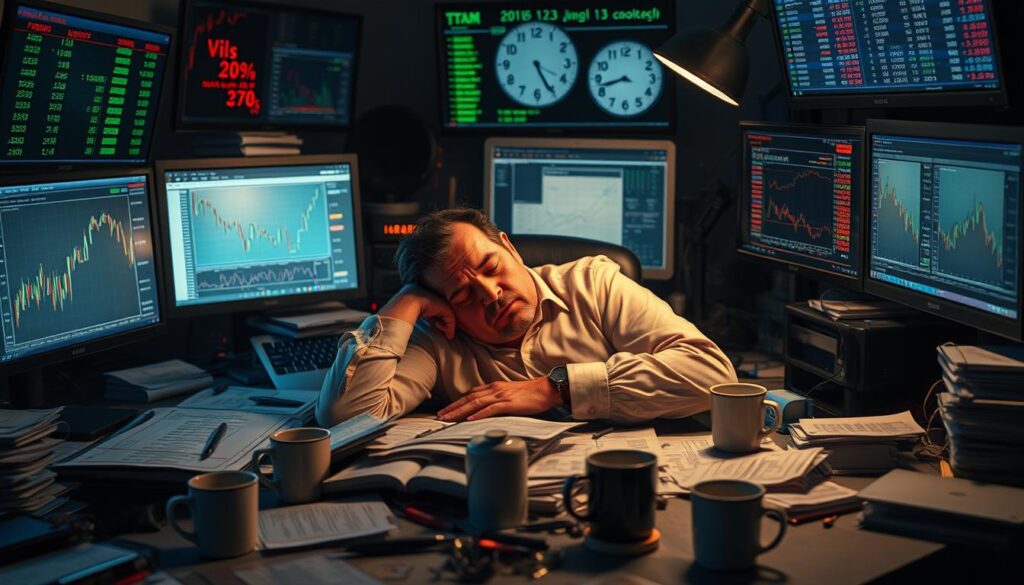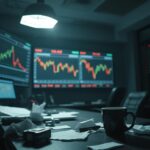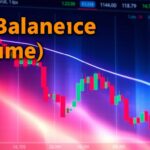Trading burnout is a complex issue that goes beyond simple fatigue. It can be a result of long hours spent analyzing the market, monitoring price changes, and the constant emotional tension that comes with managing risk and uncertainty. To avoid burnout, traders must be aware of the factors that contribute to trader fatigue and take steps to mitigate them. This can include setting clear limits, taking regular breaks, and prioritizing tasks to maintain productivity without sacrificing well-being.
As Topstep’s Trading Combine has shown, even experienced traders can struggle with the challenges of trading. With 533 traders moved to their Live Funded Account between 1/1/2023 and 12/21/2023, it’s clear that trading burnout is a real concern. By understanding the causes of trading burnout and taking proactive steps to avoid it, traders can reduce their risk of burnout and maintain their overall well-being.
Table of Contents
Key Takeaways
- Trading burnout is a complex issue that goes beyond simple fatigue
- Traders must be aware of the factors that contribute to trader fatigue
- Setting clear limits and taking regular breaks can help avoid burnout
- Prioritizing tasks can help maintain productivity without sacrificing well-being
- Incorporating physical activity, healthy eating, and mental relaxation can help prevent burnout
- Seeking help from friends or psychological counselors can alleviate burnout pressures
Understanding Trading Burnout and Its Impact
Trading stress and mental exhaustion are common issues that traders face, which can lead to burnout if not managed properly. Burnout is a state of emotional, physical, and mental exhaustion caused by excessive and prolonged stress. It can manifest in various aspects of life, including trading, and is often triggered by factors such as overtrading, lack of rest, emotional pressure, and unrealistic expectations.
Trader psychology plays a significant role in burnout, as the emotional intensity involved in trading can impact a trader’s decision-making abilities and lead to burnout if not effectively managed. Some common warning signs of burnout include questioning trade rules, experiencing physical symptoms like migraines and muscle aches, feeling self-doubt, helplessness, and anger towards others.
Causes of Trading Burnout
- Overtrading: excessive trading activities can lead to mental and physical exhaustion
- Lack of rest: inadequate breaks can result in exhaustion and decreased mental acuity
- Emotional pressure: the emotional intensity involved in trading can impact decision-making abilities
- Unrealistic expectations: overly ambitious profit targets can lead to heightened pressure and emotional strain
Recognizing the warning signs of burnout and taking steps to manage trading stress and mental exhaustion is crucial to preventing burnout. By prioritizing self-care, setting realistic goals, and maintaining a healthy work-life balance, traders can reduce their risk of burnout and maintain their mental and physical well-being.
The Hidden Costs of Trader Exhaustion
Trader exhaustion can have severe effects on trading performance, leading to financial losses and significant health impacts. The pressure to perform in the fast-paced trading environment can lead to chronic stress, sleep deprivation, and impaired cognitive function.
Some of the hidden costs of trader exhaustion include:
- Decreased productivity and accuracy
- Increased risk-taking behavior
- Poor decision-making and judgment
- Reduced job satisfaction and overall well-being
Establishing a healthy work-life balance, prioritizing self-care, and taking regular breaks can help mitigate the effects of trader exhaustion. By recognizing the health impacts of chronic stress and taking proactive steps to manage it, traders can improve their trading performance and reduce the risk of financial losses.
It is essential for traders to be aware of the hidden costs of exhaustion and take steps to prevent it. By doing so, they can maintain their physical and mental health, improve their trading performance, and achieve long-term success in the trading industry.
| Effects of Trader Exhaustion | Consequences |
|---|---|
| Chronic Stress | Impaired Cognitive Function, Reduced Job Satisfaction |
| Sleep Deprivation | Poor Decision-Making, Increased Risk-Taking Behavior |
| Poor Self-Care | Decreased Productivity, Reduced Overall Well-Being |
Early Warning Signs You’re Heading Toward Burnout
Recognizing the early warning signs of burnout is crucial for traders to take proactive steps to prevent full-blown burnout. Burnout symptoms can manifest physically, emotionally, and in trading performance. Physical symptoms may include chronic fatigue, sleep disturbances, and frequent illnesses, which can be triggered by stress indicators such as prolonged periods of stress and anxiety.
Emotional red flags can include irritability, loss of motivation, and feelings of cynicism towards trading. Trader health is also affected by emotional burnout, presenting with reduced performance and productivity, anxiety, detachment, low mood, and other symptoms. According to recent statistics, 48% of Americans experienced increased stress over the past 5 years, and 31% of employed adults have difficulty managing their work and family responsibilities.
Some common signs of burnout in traders include:
- Questioning the purpose of their trading plan
- Frequent migraines, muscle aches, and sickness despite proper diet and fitness habits
- Self-doubt, feeling helpless, trapped, and unmotivated
- Holding off on closing losing trades
- Increased substance use
- Anger towards others for small reasons
By being aware of these early warning signs, traders can take steps to manage their stress indicators, prioritize their trader health, and prevent burnout. This can include taking regular breaks, practicing self-care, and seeking support from colleagues or mental health professionals.
| Signs of Burnout | Physical Symptoms | Emotional Red Flags | Trading Performance Indicators |
|---|---|---|---|
| Chronic fatigue | Sleep disturbances | Irritability | Reduced performance and productivity |
| Frequent illnesses | Headaches | Loss of motivation | Increased indecision |
| Muscle aches | Gastrointestinal disorders | Feelings of cynicism | Deviation from trading plans |
The Role of Trading Environment in Mental Fatigue
A well-organized trading setup is crucial for maintaining focus and reducing stress. This includes considering workspace ergonomics to prevent physical strain and promote comfort during long trading sessions. A clutter-free workspace can also help minimize distractions and improve productivity.
Additionally, achieving a healthy work-life balance is essential for traders. This can be challenging, especially for those who work from home, as the lines between work and personal life can become blurred. Establishing a dedicated trading space can help create a clear separation between work and personal time, making it easier to maintain a balance between the two.
Some strategies for maintaining a healthy work-life balance include:
- Creating a schedule and sticking to it
- Setting boundaries between work and personal time
- Taking regular breaks to rest and recharge
By prioritizing workspace ergonomics and maintaining a healthy work-life balance, traders can reduce their risk of mental fatigue and improve their overall well-being. This, in turn, can lead to better trading performance and a more sustainable career in the long run.
| Strategy | Benefits |
|---|---|
| Regular breaks | Reduces stress and improves focus |
| Workspace ergonomics | Prevents physical strain and promotes comfort |
| Work-life balance | Improves overall well-being and trading performance |
Creating a Sustainable Trading Schedule
Effective time management is crucial for traders to maintain a healthy work-life integration. A well-structured trading routine can help prevent burnout and improve overall performance. By prioritizing time management, traders can ensure they have enough time for research, analysis, and execution, while also leaving space for personal activities and self-care.
Optimal Trading Hours
Identifying the optimal trading hours is essential to maximize productivity. This can be achieved by analyzing personal energy levels and focus. For example, some traders may find they are more alert and focused during the morning hours, while others may prefer the afternoon. By understanding their optimal trading hours, traders can create a schedule that suits their needs and improves their overall trading routine.
Implementing Regular Breaks
Regular breaks are vital to prevent mental fatigue and maintain focus. Techniques like the Pomodoro method can be used to take short breaks between trading sessions, allowing traders to recharge and come back to their screens with renewed energy and concentration. This approach can help traders avoid burnout and improve their overall work-life integration.
Balancing Trading with Personal Life
Achieving a balance between trading and personal life is essential for long-term success. By setting clear boundaries and prioritizing time management, traders can ensure they have enough time for personal activities, relationships, and self-care. This balance is critical to maintaining a healthy work-life integration and preventing burnout.
Essential Self-Care Practices for Traders
Trader wellness is crucial for maintaining mental and physical health. Regular exercise, such as walking or jogging, can enhance cognitive functions, boost energy levels, and improve focus. For example, Trader B, who struggled with concentration problems and sleep disturbances, introduced regular breaks and sports activities into his daily routine, resulting in significant improvements in his ability to concentrate and sleep quality.
Effective stress management is also vital for traders. This can be achieved through practices such as meditation and mindfulness, which help traders stay focused, calm under pressure, and emotionally stable. A balanced lifestyle that includes self-care activities, social connections, and hobbies outside of trading can help build resilience against burnout and maintain a healthier, more balanced lifestyle.
Some essential self-care practices for traders include:
* Regular physical exercise
* Meditation and mindfulness
* Proper nutrition
* Social connections and hobbies outside of trading
* Getting enough sleep and maintaining a healthy sleep schedule
By prioritizing mental health and incorporating these self-care practices into their daily routine, traders can reduce their risk of burnout, improve their trading performance, and enjoy a longer and more successful career.
| Self-Care Practice | Benefits |
|---|---|
| Regular Exercise | Improves focus, boosts energy levels, and enhances cognitive functions |
| Meditation and Mindfulness | Helps traders stay focused, calm under pressure, and emotionally stable |
| Proper Nutrition | Supports overall health and provides the brain with necessary fuel for efficient decision-making |
How to Avoid Trading Burnout Through Risk Management
Trading burnout can be a significant obstacle to success in the financial markets. To avoid this, it’s essential to implement effective risk management strategies. This involves creating a trading strategy that aligns with your financial goals and risk tolerance. By doing so, you can reduce the emotional toll of trading and make more informed decisions.
A well-planned financial planning approach is crucial to achieving long-term success in trading. This includes setting realistic profit targets, managing daily loss limits, and maintaining a balanced lifestyle. By prioritizing your physical and mental well-being, you can improve your decision-making skills and avoid burnout.
Position Sizing Strategies
To manage risk effectively, it’s essential to use position sizing strategies. This involves allocating the right amount of capital to each trade, based on your risk tolerance and market analysis. By doing so, you can limit your exposure to potential losses and reduce the emotional impact of trading.
Setting Realistic Profit Targets
Setting realistic profit targets is critical to avoiding burnout. This involves creating a trading strategy that aligns with your financial goals and risk tolerance. By doing so, you can avoid the pressure of unrealistic expectations and make more informed decisions.
Managing Daily Loss Limits
Managing daily loss limits is essential to preventing significant losses. This involves setting a maximum amount of capital that you are willing to lose in a single day. By doing so, you can reduce the emotional toll of trading and make more informed decisions.
- Set realistic profit targets
- Manage daily loss limits
- Use position sizing strategies
- Prioritize physical and mental well-being
By implementing these risk management strategies, you can reduce the emotional toll of trading and create a more sustainable approach to the markets. Remember to always prioritize your physical and mental well-being, and make informed decisions based on your trading strategy and financial planning approach.
Building Mental Resilience in Trading
Developing emotional control is crucial for traders to navigate the ups and downs of the market. By cultivating stress resilience, traders can better manage their emotions and make informed decisions, even in the face of uncertainty. Trading psychology plays a significant role in this process, as it helps traders understand their thought patterns and behaviors, allowing them to adapt and improve over time.
A key aspect of building mental resilience is developing a growth mindset. This involves viewing challenges as opportunities for growth and learning, rather than as threats to one’s ego or well-being. By adopting this mindset, traders can cultivate a sense of emotional control and develop the skills needed to navigate the complexities of the market. Some strategies for building mental resilience include:
- Practicing mindfulness and meditation to enhance self-awareness and emotional regulation
- Engaging in physical exercise to reduce stress and improve overall well-being
- Developing a comprehensive trading plan and sticking to it, even in the face of adversity
By incorporating these strategies into their daily routine, traders can build the mental resilience needed to succeed in the competitive world of trading. As trading psychology continues to evolve, it’s essential for traders to stay up-to-date with the latest research and techniques, ensuring they have the tools needed to maintain emotional control and achieve long-term success.
The Power of a Trading Journal
A trading journal is a valuable tool for traders, allowing them to track their emotional states, document trading patterns, and conduct performance analysis. By regularly reflecting on their trading journey, traders can gain valuable insights that can help prevent burnout and improve their overall trading performance.
Through self-reflection, traders can identify areas for improvement, such as emotional triggers that may lead to impulsive decisions. A trading journal can help traders develop a more objective understanding of their trading patterns, allowing them to make data-driven decisions rather than emotional ones.
Some benefits of maintaining a trading journal include:
- Improved self-awareness and emotional control
- Enhanced performance analysis and identification of areas for improvement
- Increased ability to develop and refine trading strategies
By incorporating a trading journal into their daily routine, traders can take a proactive approach to managing their trading performance and reducing the risk of burnout. Regular self-reflection and performance analysis can help traders stay focused, motivated, and committed to their trading goals.
Physical Exercise and Its Impact on Trading Performance
Regular physical activity is essential for traders, as it offers numerous exercise benefits that can improve trading performance. Fitness for traders is not just about physical health; it also has a significant impact on mental well-being and stress reduction. By incorporating exercise into their daily routine, traders can enhance their cognitive function, leading to better focus and decision-making abilities.
Some of the ways exercise benefits traders include improved blood circulation, which enhances cognitive functions, and strength training, which helps build muscle and improve endurance. Even short bursts of activity can have significant benefits, such as reducing stress and anxiety. Traders can engage in various physical activities, such as cardiovascular workouts like swimming, cycling, or walking, to improve their overall health and well-being.
Here are some tips for traders to incorporate exercise into their busy schedule:
- Start with short, manageable sessions, such as 10-15 minute walks or stretching exercises
- Find an exercise routine that you enjoy, whether it’s yoga, Pilates, or weightlifting
- Schedule exercise into your daily planner, just like you would any other important task
By prioritizing physical health and incorporating exercise into their daily routine, traders can build resilience against burnout, improve their concentration, and maintain the stamina needed for long-term success in the markets. Remember, fitness for traders is not just about physical health; it’s also about mental well-being and stress reduction.
| Exercise Type | Benefits for Traders |
|---|---|
| Cardiovascular workouts | Improved blood circulation, enhanced cognitive function |
| Strength training | Improved endurance, increased muscle mass |
| Yoga and Pilates | Reduced stress and anxiety, improved flexibility |
Developing Healthy Trading Habits
Establishing effective trading routines is crucial for maintaining a healthy work-life balance and cultivating productivity habits. By incorporating mindful morning routines and relaxing evening wind-down practices, traders can improve their overall well-being and trading performance.
A well-structured morning routine may include mindfulness practices, such as meditation or deep breathing exercises, to help traders stay focused and composed. Additionally, reviewing market trends and setting daily goals can help traders develop a sense of control and direction.
In the evening, traders can benefit from wind-down practices like journaling, reading, or engaging in a relaxing activity to disconnect from the markets and prepare for restful sleep. Consistency is key when it comes to these routines, as it helps create a sense of stability and normalcy in the often unpredictable world of trading.
Some examples of healthy trading habits include:
- Setting realistic goals and expectations
- Practicing patience and discipline in trading decisions
- Engaging in regular physical exercise to improve mental clarity
- Seeking support from peers or mentors to stay motivated and accountable
By prioritizing trading routines, productivity habits, and work-life balance, traders can reduce their risk of burnout and improve their overall trading performance. As Brett Steenbarger, a renowned trading psychology expert, notes, “Confidence in trading is built through effort, preparation, and a deep understanding of the trading strategy.”
“The key to successful trading is not just about making profitable trades, but also about maintaining a healthy and balanced lifestyle.”
| Healthy Trading Habits | Benefits |
|---|---|
| Regular exercise | Improves mental clarity and focus |
| Mindfulness practices | Enhances emotional control and discipline |
| Consistent sleep schedule | Supports physical and mental well-being |
The Importance of Trading Breaks and Vacations
Regular breaks and vacations are essential for maintaining a healthy work-life balance and preventing trader burnout. Chronic fatigue, decreased motivation, and increased stress are common symptoms of burnout that can significantly impact trading performance. Taking time off allows traders to recharge, reducing the risk of burnout and improving overall mental health.
A simple way to overcome burnout is to take regular breaks during trading sessions. This can include using the Pomodoro technique or scheduling non-trading activities. Longer breaks, such as weekends off and vacations, provide much-needed perspective and mental rejuvenation. According to research, 75% of people say vacation improves their mental health, and 49% say it contributes to their physical health as well.
Some benefits of taking breaks and vacations include:
* Improved decision-making and concentration
* Renewed enthusiasm and motivation
* Better overall mental health and work-life balance
* Increased productivity upon return to trading
By prioritizing breaks and vacations, traders can maintain their mental sharpness, reduce the risk of burnout, and improve their overall quality of life. It’s essential to remember that taking time off is not a luxury, but a necessity for maintaining peak trading performance and trader burnout prevention.
Technology and Tools to Prevent Trader Fatigue
Traders can leverage trading technology to reduce the cognitive load and prevent burnout. By automating repetitive tasks, traders can focus on high-level decision-making and strategy development. Automation tools such as algorithmic trading systems and copy-trading platforms can help traders manage their workload and minimize the risk of fatigue.
Additionally, traders can utilize mental health resources such as mobile apps and online platforms to monitor and manage their stress levels, improve focus, and promote overall well-being. These tools can provide traders with personalized recommendations and strategies to mitigate the negative effects of trading burnout.
Benefits of Trading Automation Solutions
- Reduced cognitive load and mental fatigue
- Improved trading performance and accuracy
- Enhanced risk management and control
By incorporating trading technology and automation tools into their trading practice, traders can create a more sustainable and less stressful trading environment. Furthermore, utilizing mental health resources can help traders develop the resilience and coping strategies needed to navigate the challenges of trading and maintain their overall well-being.
Building a Support Network in Trading
As a solo trader, being isolated can lead to significant burnout since you are responsible for doing all the research and trading. At times, being alone under pressure can lead to significant mental exhaustion. This is where building a support network comes in – connecting with other traders can provide emotional support, knowledge sharing, and a sense of community.
A trader community can be a valuable resource for traders, offering a platform to share experiences, discuss challenges, and celebrate successes. Mentorship opportunities can also be beneficial, providing guidance and support from experienced traders. Additionally, peer support can help traders stay motivated and accountable, which is essential for maintaining a healthy trading psychology.
Some ways to build a support network include joining online trading forums, attending trading meetups or conferences, and seeking out mentorship opportunities. By connecting with other traders, you can gain valuable insights, learn from their experiences, and develop a sense of belonging to a trader community. This can help mitigate the risks of burnout and improve overall trading performance.
By building a support network, traders can access a wealth of knowledge, experience, and emotional support, which can help them navigate the challenges of trading and achieve their goals. With the right support, traders can stay focused, motivated, and committed to their trading strategy, even in the face of adversity.
Conclusion: Maintaining Long-Term Trading Success Through Balance
Sustainable trading success requires striking a healthy balance between the demands of the markets and the needs of your personal well-being. By implementing the strategies we’ve discussed, you can not only avoid the pitfalls of trading burnout but also enhance your long-term performance and overall quality of life.
Regular self-care practices, effective risk management, and the development of mental resilience are the keys to maintaining a sustainable trading career. Remember, trading is a marathon, not a sprint, and the rewards of long-term success come to those who prioritize their trader well-being.
Stay vigilant for the early warning signs of burnout, and don’t hesitate to take breaks, seek support, and adjust your routine as needed. With a balanced approach to your trading and personal life, you’ll be well-positioned to overcome the challenges of the markets and achieve the sustainable trading success you deserve.
FAQ
What is trading burnout and how does it impact traders?
Trading burnout is a complex issue that arises from the constant stress and pressure experienced by traders in the fast-paced financial markets. It can lead to decreased trading performance, financial losses, and even mental health issues like depression and anxiety.
What are the early warning signs of trading burnout?
The early warning signs of trading burnout can include physical symptoms like chronic fatigue, emotional red flags such as irritability and loss of motivation, and indicators related to trading performance like increased indecision and lack of discipline.
How can a trader’s environment contribute to or prevent burnout?
The trading environment plays a significant role in preventing burnout. Factors like creating a dedicated and ergonomic trading space, maintaining a clutter-free workspace, and ensuring a healthy work-life balance can all contribute to a more sustainable trading practice.
What are the key strategies for building mental resilience in trading?
Building mental resilience in trading involves developing a growth mindset, techniques for emotional control, and cognitive behavioral strategies to reframe negative thoughts. These skills can help traders better withstand the ups and downs of the market without succumbing to burnout.
How can technology and tools be leveraged to prevent trader fatigue and burnout?
Technology can be a valuable ally in preventing trader fatigue and burnout. Trading automation solutions, algorithmic trading systems, and mental health apps can all help reduce the cognitive load on traders and promote overall well-being.
Why is it important for traders to build a support network?
Building a support network of fellow traders can provide emotional support, knowledge sharing, and a sense of community. This can help combat the isolation that can contribute to burnout and enhance a trader’s overall experience in the markets.









